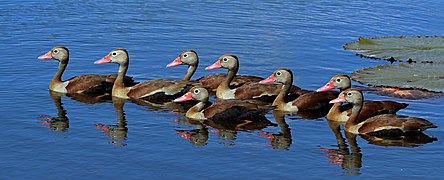Portal:Trinidad and Tobago
Trinidad and Tobago Portal
The Republic of Trinidad and Tobago is a country located at the southern tip of the Caribbean. It borders the countries of Grenada and Venezuela. It was the first Caribbean country to host the Summit of the Americas. It shares maritime boundaries with other nations including Barbados to the northeast, Guyana to the southeast, and Venezuela to the south and west. A treaty between the Republic of Trinidad and Tobago and the Republic of Venezuela on the delimitation of marine and submarine areas, 18 April 1990. The country covers an area of 5,128 square kilometres (1,980 sq mi) and consists of two eponymous main islands, Trinidad and Tobago, and numerous smaller landforms. Trinidad is the larger and more populous of the main islands; Tobago is much smaller, comprising about 6% of the total area and 4% of the entire population which is estimated at 1.3 million (2005). Unlike most of the English-speaking Caribbean, Trinidad and Tobago's economy is primarily industrial with an emphasis on petroleum and petrochemicals. Trinidad and Tobago is well known for its African and Indian cultures, reflected in its large and famous Carnival, Diwali, and Hosay celebrations, as well being the birthplace of steelpan, the limbo, and music styles such as calypso, soca, rapso, parang, chutney, and chutney soca.[1][2][3][4][5][6][7] Selected article -The National Union of Freedom Fighters (NUFF) was an armed Marxist revolutionary group in Trinidad and Tobago. Active in the aftermath of the 1970 Black Power Revolution, the group fought a guerrilla warfare campaign to overthrow the government of Prime Minister Eric Williams following the failed Black Power uprising and an unsuccessful mutiny in the Trinidad and Tobago Regiment. NUFF formed out of the Western United Liberation Front (WOLF), a loose grouping of largely unemployed men in the western suburbs of Port of Spain. After the failed mutiny, members of WOLF decided to overthrow the government through armed rebellion. In 1971 they attempted to assassinate the lead prosecutor of the mutineers and a coast guard officer who helped suppress the army mutiny. (Full article...)CategoriesSelected quoteIn the news
WikiProject
General imagesThe following are images from various Trinidad and Tobago-related articles on Wikipedia. Selected pictureDid you know
Selected cuisine
Pholourie (), also spelled phulourie or phoulourie, is a snack food commonly eaten in Trinidad and Tobago and also known in Guyana and Suriname. It consists of fried, spiced dough balls that are served with a chutney. The dough is made up of flour, ground split peas, water, and spices. Depending on the recipe, green seasoning, garlic, pepper, turmeric, onions and/or cumin are used. Then dough balls the size of golf balls are formed and fried afterwards. The fried balls are usually served with a chutney to dip them in, usually tamarind or mango. They are also added to Karhi.
Selected panoramaThe Twin Towers are landmarks in downtown Port of Spain. (2002)
TopicsLists
Select [►] to view subcategories
Recognized content
Featured articlesFeatured listsGood articles
Did you know? articles
Featured pictures
Featured portalsIn the News articles
Main page featured articlesMain page featured listsPicture of the day pictures
Related portalsWikiProjectsTrinidad and Tobago Wikipedians' Notice Board · Trinidad and Tobago Wikipedians
Associated WikimediaThe following Wikimedia Foundation sister projects provide more on this subject:
Portal informationThis portal is maintained by WikiProject Trinidad and Tobago
Discover Wikipedia using portals |
|||||||||||||||||||||||||||||||||||||||||||||||||||||||||||||||
- ^ "In Trinidad, Diwali Lights Up Like Christmas". NPR. Archived from the original on 17 February 2020. Retrieved 20 March 2019.
- ^ "Diwali in Trinidad and Tobago". trinidad.us. Archived from the original on 2 March 2019. Retrieved 20 March 2019.
- ^ Ingram, Amy. "What is Chutney Music?". Wesleyan University. Archived from the original on 16 July 2011. Retrieved 10 September 2018.
- ^ "Parang Music". Destination Trinidad and Tobago. Archived from the original on 10 September 2018. Retrieved 10 September 2018.
- ^ "Soca Music History". Artdrum. Archived from the original on 19 September 2018. Retrieved 10 September 2018.
- ^ "A brief history of the steel pan". BBC. 24 July 2012.
- ^ "Trinidad Carnival for Beginners". Caribbean Beat. 1 January 1993. Archived from the original on 8 April 2018. Retrieved 10 September 2018.

































































